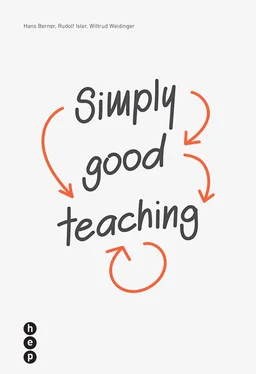Overlapping
Unavoidable disciplinary problems should be dealt with “in passing” and without much fuss so as not to disrupt the flow of teaching more than necessary. The preparation and implementation of media elements should occur routinely (automatically, so to speak), so that the focus of attention remains on the class. Generally speaking, it is important that work proceeds simultaneously on various problems and that individual student needs are addressed.
Speed, smooth flow, momentum
Needless disruptions of class the flow should be avoided. The precondition for this is adequate lesson planning, particularly the avoidance of rush (overload of material) and boredom (lack of sufficient material, monotonous work). A negative example of lacking flow is sticking to notes and small pieces of paper. Another example is idling verbosity or over-problematizing minor details.
Group activation (group focus)
Even when only one student is at the center of activities, all students must follow the class proceedings, with the teacher maintaining the focus on the whole class or group. For example, the class receives clear instructions before the teacher engages in a dialog with an individual student.
Managing transitions
The transitions between different teaching segments or phases should occur through a short and unambiguous segue (for example: acoustic signals, certain gestures) and without loss of time. Rest breaks or relaxation pauses can be granted, rituals for de-escalation may be instituted.
Avoiding mock participation
Teachers should be aware of feigned attentiveness; students are known to develop clever rituals to create the appearance of rapt attention and lively interest (intense head-nodding, furrowing their brows in apparent concentration, etc.); commonly known as "school survival skills".
In addition to an actualized presentation of these six principles, Nolting’s publication also deals with direct and cooperative interventions in cases of conflicts in the school. The suggested recommended actions are concrete and thereby very helpful.
In the other referenced publication thus far, Rüedi’s Discipline and self-discipline in the school ,22 which deals first and foremost with the relational dynamics of classroom instruction, such prescription-like suggestions are hard to find. In reference to Rüedi (see p. 46), we are only presenting a self-test for the purpose of triggering a useful discussion within the discipline in terms of the relationship between teachers and learners.
3 Increase the proportion of real learning in your classroom instruction
Increasing the actual learning time while reducing the unproductive time is easily achievable and requires no further elaboration. The important thing is to periodically focus on this aspect. Meticulous teaching preparation with attention to seamless transitions is helpful for this reason, as discussed in the chapters that follow. See chapter 9 for especially useful suggestions in this regard.
4 Appeal to your students’ completely different motives
It is hardly useful to consider the students’ intrinsic motivations to learn as good, and the extrinsic one as problematic. Extrinsic motivation is unavoidable in a complex civilization: you will never just be doing what you want to do. It is rather problematic, however, to ascribe an effect, based exclusively on content-unrelated motives, such as rewards, obedience, and grades. If you, as the instructor, set high expectations and serve as a role model for the learners yourself, you are within the area of extrinsic motivation. This is also the case if you produce cognitive conflicts – that is, situations in which students’ acquired knowledge clashes with new knowledge, and the learners are unable to explain a phenomenon based on their current knowledge.
The intrinsic motivations which can be addressed are highly varied and different depending on the student. However, the following motivations apply to most of students: enjoying the challenge, curiosity, imagination, as well as a need for control or prestige, etc.
For a useful, deeper analysis of the theoretical foundations of motivation and possibilities of action, see Emotion, Motivation und selbstreguliertes Lernen (Emotion, motivation and self-regulated learning) by Thomas Götz.23 Under the rubric motivation, we have also subsumed the conviction of self-efficacy, Under the category ‘motivation’ we have also subsumed the convictions of self-effectiveness, that is the subjective conviction of being able to cope with new requirements on your own. Strengthening the self-efficiency of students is one of the most important tasks of teachers. Three powerful strategies are available for this.24 Self-effectiveness improves the most when the students overcome difficulties on their own while being aware that they have achieved the feat themselves. The second most important factor is human models, for instance classmates, who are within reach and who master difficulties (e.g. math problems); this point indicates the importance of peers. In third place, there is the encouragement by the teacher – not just in the sense of “You know this!” but in the sense of “Try it, I will help you if you get stuck!” (see chapters 3 and 8).
5 Place challenging performance expectations on your students
Challenging performance expectations must be explicitly stated to the students. For instance, the demands could be formulated as follows in language classes: clearly and correctly articulated pronunciation, use of appropriate words when speaking, giving a short presentation speech based on key words, grammar and spelling when writing, etc. If the students lack confidence, it is not advisable to reduce the demands too quickly, as a reduction of requirements would suggest the unspoken message that one lacks confidence in the learners’ abilities. An under-challenging situation appears more problematic than an overchallenge. In the context of learning expectations, it is also very important to refrain from quick praise or heaping praise on students; not every minor performance should be acknowledged with “very good!”. Only a performance that corresponds to the prerequisites of the learner or learners should be acknowledged with “good” or “very good”. Moreover, there are many nuances such as “the beginning is promising, keep on trying!” etc.
6 Observe clarity in content and structure
Clarity in content and structure derives from professional lesson planning, as described in detail in chapter 9. Furthermore, there are other specific tips in chapter 2 and in the following explanations concerning the “rhythmization” and articulation of lessons.
7 Make learning easier for your students through “rhythmization” and clear articulation
The start and end of a lesson are without doubt very important in the context of the rhythmization of teaching. The lesson beginnings have a diverse function. Knowing this function helps with planning and starting the lesson in the most appropriate way. It is a matter of:
–providing the learners with information about the material and subject at hand
–generating learner interest, producing a certain tension
–posing a question
–producing a sense of responsibility for the ongoing lesson
–establishing attentiveness and concentration
–linking elements from previous lessons with the topic of the current session
–ensuring that the topic enters and broadens the students’ horizons.
The function of the lesson end is to render the learned material visible in a brief review. First and foremost, the end of the lessons must be planned in such a manner that the most important content or the homework assignments will not have to be squeezed in at the ring of the bell.
Читать дальше












